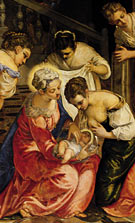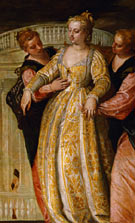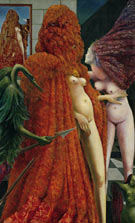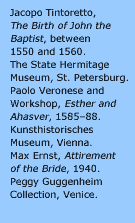 |
 |
 |
 |
|
| Connecting Museums at the Kunsthistorisches Museum, Vienna |
||
The city of Venice connects the three paintings assembled here. The works by Veronese and Tintoretto—with Titian the principal masters of sixteenth century Venetian Art—are from the collections of the Kunsthistorisches Museum in Vienna and the State Hermitage in St. Petersburg. They are imbued with the luxurious sense of color that earned Venice a special place on the map of Italian painting. Both canvasses confirm not only the painterly, but also the dramatic and narrative skills of their creators. From the city of islands, they reached their final destinations via the Netherlands and England, and France respectively. The painting by Max Ernst, combining lush colors and visionary motifs, traveled in the opposite direction. Executed 60 years ago in the south of France, it became part of the Peggy Guggenheim Collection in Venice. The unfinished Palazzo Venier dei Leoni on the Grand Canal, host of the collection since 1949, is only steps from the Gallerie dell' Accademia, where many works by Veronese and Tintoretto are on display. The Birth of John the Baptist by Jacopo Tintoretto dates from between 1550 and 1560. This panel, most notable for its register of red hues and its detailed and dynamic composition, attests to Tintoretto's capacity to cast groups of contorted figures in glowing colors against a dark background. The patron of this major work remains unknown. In the seventeenth century it surfaced in the collection of Cardinal Mazarin, and in the following century we find it in the possession of the famous French collector and connoisseur Pierre Crozat (1665–1740). In 1772, Catherine the Great bought the Crozat Collection—with more than 400 paintings one of the largest in Paris—for the Hermitage. Through the acquisition of entire collections, the Hermitage expanded rapidly in those years and emerged as one of Europe's leading art galleries. The composition Esther and Ahasver by Paolo Veronese illustrates with similar clarity the formal principles of Tintoretto's younger contemporary. The setting is not an interior, but a stage-like terrace presenting the narrative within a classicist frame. This work belongs to a series of ten oblong canvasses of equal size with scenes from the Old and New Testament. That neither the patron nor the original installation site are known is remarkable, considering the size of the commission. The low angle of sight suggests a sequential placement at a great distance from the viewer. The series, dating from 1585 to 1588, is one of the last works of the master. It was only partially executed by his own hand. Either it never reached its intended location and was finished only after the artist's death by his workshop, or it was removed rather quickly. Be that as it may, thirty years after its presumed creation we find the series in the estate of Charles of Croy, Duke of Aerschot, in the Netherlands. The paintings were christened the Buckingham series after their next owner, the Duke of Buckingham, who was for a long time thought to be the first. The heirs of the Duke, who had been murdered in 1628, brought the paintings during the English Civil War back to the Netherlands. There, the Archduke Leopold Wilhelm, governor of the Spanish Netherlands, bought them in 1650 in the name and on account of his brother, Emperor Ferdinand III. They were intended for the Prague Kunstkammer, which had been plundered by Swedish troops at the end of the Thirty Years War. Not until the eighteenth century were the paintings moved to the Imperial Galleries in Vienna, where they were united with later purchases by Leopold Wilhelm, especially numerous works by Giorgione, Titian, Tintoretto, and Veronese from the collection of the Duke of Hamilton. The great collection of Venetian paintings—to this day a highlight of the Kunsthistorisches Museum—is almost entirely the result of the activities of Archduke Leopold Wilhelm during his governorship of the Netherlands (1647–56). Tintoretto's Hermitage painting retells the birth of John the Baptist. The focal point of the composition is not the exhausted mother Elizabeth but the maids nursing the newborn child, and John's father Zachary standing to their right. Due to its similarity to another and more common theme, the painting carried the title The Birth of the Virgin Mary in the Mazarin Collection. Despite the symbolic details referring to John the Baptist (the rooster, the charred bones), the thematic uncertainty has been resolved only very recently. The figure arrangement is nonetheless very convincing, reminding us of Veronese's work in this selection, which captures one of the most dramatic and popular stories told in the Scriptures. The Book of Esther in the Old Testament recounts how the Jews were saved from Persian persecution. Mordecai, a Jew living in the court of Xerxes I (Ahasuerus or Ahasver) in Susa, uncovers a conspiracy and saves the life of the king. The royal minister Haman hates Mordecai and plots to destroy the Jews. Without knowing her origin, King Ahasuerus had chosen Esther, the niece and adopted daughter of Mordecai, to become his queen. Her uncle orders her to intervene with Ahasuerus on behalf of her people—a dangerous mission: All the king's servants ... do know, that whosoever, whether man or woman, shall come unto the king into the inner court, who is not called, there is one law of his to put him to death, except such to whom the king shall hold out the golden sceptre, that he may live. (4:11) The longer Greek version of the text captures the atmosphere at the court of the ancient tyrant: She [Esther] took two maids with her; on one she leaned gently for support, while the other followed, carrying her train. She was radiant with perfect beauty, and she looked happy, as if beloved, but her heart was frozen with fear. When she had gone through all the doors, she stood before the king. He was seated on his royal throne, clothed in the full array of his majesty, all covered with gold and precious stones. He was most terrifying. Lifting his face, flushed with splendor, he looked at her in fierce anger. The queen faltered, and turned pale and faint, and collapsed on the head of the maid who went in front of her. (15:4–19) Veronese adhered closely to the biblical text and contrasted the illuminated Esther—whom Middle Age belief considered a precursor of the Virgin Mary—with a gloomy king. In Max Ernst's self-titled painting La toilette de la mariée (Attirement of the Bride), signed and dated 1940, we encounter a completely different kind of bride. It is one of the last works finished in France before he emigrated to the United States the following year, and also one of his last works as a member of the Surrealist movement. For Ernst, these were times of political danger and private confusion. He was arrested as a foreign enemy in Vichy, France and separated from his lover and former student Leonora Carrington, an author of Surrealist prose. To escape from Europe, Carrington later married a Mexican friend, while Max Ernst accompanied his new mistress Peggy Guggenheim to America. In her memoirs, Peggy Guggenheim complains about the artist's enduring and desperate affection for Carrington. La toilette de la mariée is less a figurative narration than an allegory, assembling its vision from realistic elements and strange symbols. The artist encodes his secret intuitions and obsessions into a private mythology. The evocative, fantastic, and enigmatic imagery offers several layers of meaning. Surrealist art aimed at an almost automatic emergence from the subconscious, emphasized here by the random nature of the applied painting technique décalcomanie. Of equal significance is the intellectual escapism of the artist, his erudition and his intimate knowledge of art history. His alchemical studies, his preoccupation with the witch trials and his interest in the art of Hans Baldung Grien have all been noted as possible sources of influence. Rather than being derived from sixteenth-century Italian art, the mannerist vocabulary is most intimately related to German and Dutch art and to the hybrid creatures of Hieronymus Bosch. —Karl Schütz |



